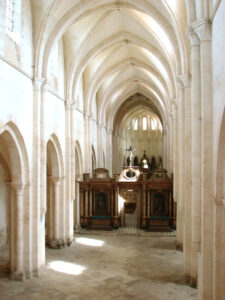Our Pause Midi series resumed on September 13 with a presentation about Pontigny Abbey by Dr. Terryl Kinder of Saint Michael’s College.
Dr. Kinder described her decades of work studying the twelfth-century Pontigny Abbey, located in Burgundy, France. Founded in 1114, it of some importance architecturally as it bears both Romanesque and Gothic features. Burgundy, a stronghold of the Romanesque style, but the abbey’s ribbed vaults were the first Gothic element to appear in the region.
Today the structure is renowned for its austerity and the luminous beauty. Dr. Kinder calls it the “abbaye de lumière” because it’s made out of white limestone, which looks gray in books but is much lighter in person.
Dr. Kinder explained the difference between an abbey and a cathedral. A cathedral is a bishop’s seat, whereas an abbey is a building for a community of monks or nuns. The Pontigny abbey was founded by the Cistercian order, which is part of the Benedictine family—that is, the monks who resided there followed the rule of Saint Benedict. There they copied books and promoted learning. With its extensive garden, the abbey was self-sufficient.
Pontigny is familiar to some Vermonters as it is the place of origin of the Edmundites, or the Society of Saint Edmund (SSE). The remains of Saint Edmund himself are entombed in the Pontigny abbey. The society was established in the 19th century by a group of priests who were inspired by Saint Edmund. They later fled France, traveled to the United States, and initiated Saint Michael’s College.
Dr. Kinder has studied the social history of the abbey minutely, through old drawings, maps, and engravings, as well as later photos and postcards. They show that it was long a destination for pilgrimages.
She has meticulously examined the physical aspects of the abbey as well: the structure, the altar, the furniture, the organ, the choir stall, the Saint Edmund tomb. By looking at old drawings and photos, she can see how the structures have been used over time.
When the Edmundites left France around 1900 and settled in Vermont, they brought with them a trove of documents, which Dr. Kinder also studies.
So meticulous is her research that she has a database in which every stone has been entered, from every column and capital. Every stone has a mark on it, called a mason’s mark. Every mark is recorded. In 1999 the roof was replaced, so she was able to study the timber frame.
Dr. Kinder has been studying the abbey for thirty years. She spends six months out of every year at her home in Pontigny. In 2022 the François Schneider Foundation has bought the abbey’s domain and will make it into a center for contemporary art.
Watch the video of Dr. Kinder’s presentation here.
–Janet Biehl
Terryl N. Kinder is a practicing archaeologist who specializes in the study of the Cistercians, a monastic order founded in 1098 in Burgundy. She is editor in chief of Cîteaux, an international journal of Cistercian history. In her numerous articles and books, she has examined the architecture, archaeology, and land management of the 12th-century abbey of Pontigny. Since 2004 she has been a Distinguished Visiting Professor at Saint Michael’s College, where she teaches ancient and medieval art and architecture. She is currently an adviser to the Fondation François Schneider.

